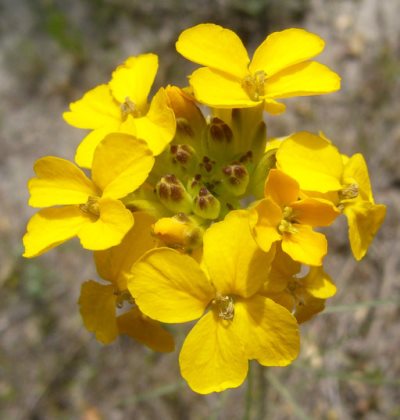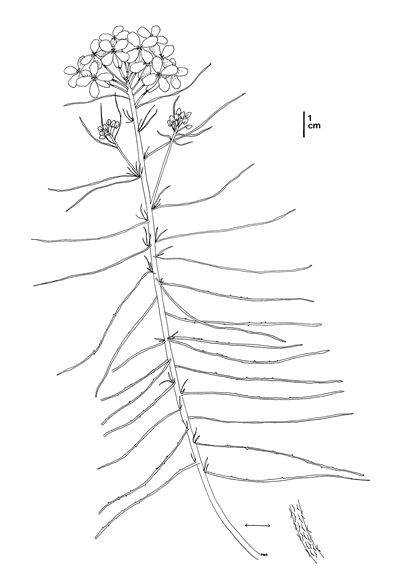Erysimum teretifolium
 Erysimum teretifolium. Photo © Zoya Akulova.
Erysimum teretifolium. Photo © Zoya Akulova.
 Erysimum teretefolium. CDFW illustration by Mary Ann Showers. (Click to enlarge)
Erysimum teretefolium. CDFW illustration by Mary Ann Showers. (Click to enlarge)
Santa Cruz wallflower was listed as a California endangered plant species in 1981, which means that killing or possessing this plant is prohibited by the California Endangered Species Act (CESA). Santa Cruz wallflower is also listed as endangered under the federal Endangered Species Act. Santa Cruz wallflower is a short-lived perennial or annual plant in the mustard family (Brassicaceae). When the plant is young it consists of a rosette of low narrow green and purple leaves. As the plant matures, the rosette of leaves withers and the plant produces narrow leaves on the flower stalk. Santa Cruz wallflower blooms February through May with four-petaled yellow flowers. Santa Cruz wallflower pollinators include chalcedon checkerspot butterflies (Euphydryas chalcedona), ants, European honey bees, and bumble bees.
Santa Cruz wallflower is endemic to the nutrient-poor, coarse sand soils of the Sand Hills of Santa Cruz County, and it primarily grows in open areas away from dense vegetation. The Sand Hills arose from an ancient seabed that was exposed during the formation of the Santa Cruz Mountains. Santa Cruz wallflower has been found to favor areas that are free of vegetation and leaf litter such as disturbed soils near sand slides and trails.
According to the California Natural Diversity Database, there are currently 11 extant populations of Santa Cruz wallflower but only four are considered secure. One of the secure populations is on
Quail Hollow Ranch County Park managed by Santa Cruz County, one is on
Bonny Doon Ecological Reserve managed by CDFW, and two are on privately-owned lands. At the time it was federally listed, the main threat to Santa Cruz wallflower was habitat removal and fragmentation caused by sand mining. Now that most quarry operations have stopped, the greatest threat to the persistence of Santa Cruz wallflower is habitat alteration due to vegetation encroachment. Trees such as ponderosa pine (
Pinus ponderosa) and oaks (
Quercus spp.)
are infringing on Santa Cruz wallflower habitat, resulting in increased canopy cover and litter accumulation. Santa Cruz wallflower is a fire-adapted species, and fire suppression is allowing ground litter to accumulate, contributing to degradation of its habitat. Observations show that several invertebrate and vertebrate herbivores eat Santa Cruz Wallflower, including caterpillars, rabbits, deer, and gophers. The
2008 Santa Cruz Wallflower 5-Year Review (PDF) by the U.S. Fish and Wildlife Service acknowledges that the threats to the species have resulted in an overall decline in population numbers, and remaining stable populations of Santa Cruz wallflower are attributed to active management.
The Land Trust of Santa Cruz County, researchers from San Jose State University and Santa Clara University, the U.S. Fish and Wildlife Service, and the California Department of Fish and Wildlife (CDFW) have contributed efforts and funding to conserve Santa Cruz wallflower. Despite this support, only about 20 percent of existing populations were protected from development in 2008. Studies occurring on the Bonny Doon Ecological Reserve managed by CDFW are testing the effects of manual removal of ground litter and vegetation, which may provide insight for future conservation efforts. Future surveys and monitoring could provide better information on population trends and inform management plans. Research on prescribed burning is needed to explore the possibility of mimicking natural fire cycles to reopen habitat for Santa Cruz wallflower.
CDFW has participated in the following Santa Cruz wallflower studies and projects with support from the Cooperative Endangered Species Conservation Fund, the Rare and Endangered Species Preservation FundRare and Endangered Species Preservation Fund, and other mechanisms:
CDFW may issue permits for Santa Cruz wallflower pursuant to CESA, and you can learn more about California laws protecting Santa Cruz wallflower and other California native plants. Populations of Santa Cruz wallflower occur in CDFW’s Central Region. More information is also available from the U.S. Fish and Wildlife Service Species Profile for Santa Cruz wallflower.
Updated 3/14/2017